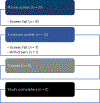Senolytic therapy in mild Alzheimer's disease: a phase 1 feasibility trial
- PMID: 37679434
- PMCID: PMC10875739
- DOI: 10.1038/s41591-023-02543-w
Senolytic therapy in mild Alzheimer's disease: a phase 1 feasibility trial
Abstract
Cellular senescence contributes to Alzheimer's disease (AD) pathogenesis. An open-label, proof-of-concept, phase I clinical trial of orally delivered senolytic therapy, dasatinib (D) and quercetin (Q), was conducted in early-stage symptomatic patients with AD to assess central nervous system (CNS) penetrance, safety, feasibility and efficacy. Five participants (mean age = 76 + 5 years; 40% female) completed the 12-week pilot study. D and Q levels in blood increased in all participants (12.7-73.5 ng ml-1 for D and 3.29-26.3 ng ml-1 for Q). In cerebrospinal fluid (CSF), D levels were detected in four participants (80%) ranging from 0.281 to 0.536 ml-1 with a CSF to plasma ratio of 0.422-0.919%; Q was not detected. The treatment was well-tolerated, with no early discontinuation. Secondary cognitive and neuroimaging endpoints did not significantly differ from baseline to post-treatment further supporting a favorable safety profile. CSF levels of interleukin-6 (IL-6) and glial fibrillary acidic protein (GFAP) increased (t(4) = 3.913, P = 0.008 and t(4) = 3.354, P = 0.028, respectively) with trending decreases in senescence-related cytokines and chemokines, and a trend toward higher Aβ42 levels (t(4) = -2.338, P = 0.079). In summary, CNS penetrance of D was observed with outcomes supporting safety, tolerability and feasibility in patients with AD. Biomarker data provided mechanistic insights of senolytic effects that need to be confirmed in fully powered, placebo-controlled studies. ClinicalTrials.gov identifier: NCT04063124 .
© 2023. This is a U.S. Government work and not under copyright protection in the US; foreign copyright protection may apply.
Conflict of interest statement
Competing interests
M.M.G. reports personal stock in Abbvie. R.C.P. reports personal fees from Roche, no personal fees from Eisai, and personal fees from Genentech, personal fees from Eli Lilly and personal fees from Nestle, outside the submitted work. R.C.P. receives royalties from Oxford University Press and UpToDate and receives fees from Medscape for educational activities. J.L.K. and T.T. have a patent for Killing Senescent Cells and Treating Senescence-Associated Conditions Using an SRC Inhibitor and a Flavonoid with royalties paid to Mayo Clinic by Unity Biotechnologies and a patent for Treating Cognitive Decline and Other Neurodegenerative Conditions by Selectively Removing Senescent Cells from Neurological Tissue with royalties paid to Mayo Clinic by Unity Biotechnologies. S.C. reports Scientific Advisory Board membership for T3D Therapeutics and the Neurodegenerative Consortium, outside the submitted work. M.E.O., H.Z. and S.K.D. have a patent for Biosignature and therapeutic approach for neuronal senescence, which is pending. The remaining authors declare no competing interests.
Figures





Update of
-
Senolytic therapy to modulate the progression of Alzheimer's Disease (SToMP-AD) - Outcomes from the first clinical trial of senolytic therapy for Alzheimer's disease.Res Sq [Preprint]. 2023 Apr 24:rs.3.rs-2809973. doi: 10.21203/rs.3.rs-2809973/v1. Res Sq. 2023. Update in: Nat Med. 2023 Oct;29(10):2481-2488. doi: 10.1038/s41591-023-02543-w. PMID: 37162971 Free PMC article. Updated. Preprint.
References
-
- Prince MJ et al. World Alzheimer Report 2015—The Global Impact of Dementia: An Analysis of Prevalence, Incidence, Cost and Trends (Alzheimer’s Disease International, 2015).
-
- Aisen PS et al. The future of anti-amyloid trials. J. Prev. Alzheimers Dis. 7, 146–151 (2020). - PubMed
-
- Korczyn AD Mixed dementia—the most common cause of dementia. Ann. N. Y. Acad. Sci. 977, 129–134 (2002). - PubMed
Publication types
MeSH terms
Substances
Associated data
Grants and funding
- T32 AG021890/AG/NIA NIH HHS/United States
- R01 NS017950/NS/NINDS NIH HHS/United States
- R01 AG054076/AG/NIA NIH HHS/United States
- RF1 AG059421/AG/NIA NIH HHS/United States
- R01 AG068030/AG/NIA NIH HHS/United States
- R01 AG033193/AG/NIA NIH HHS/United States
- R01 AG065301/AG/NIA NIH HHS/United States
- R01 AG080821/AG/NIA NIH HHS/United States
- R01 AG068293/AG/NIA NIH HHS/United States
- I01 BX005717/BX/BLRD VA/United States
- R01 AG075684/AG/NIA NIH HHS/United States
- U24 AG057437/AG/NIA NIH HHS/United States
- RF1 AG065301/AG/NIA NIH HHS/United States
- R01 AG069690/AG/NIA NIH HHS/United States
- U01 AG046170/AG/NIA NIH HHS/United States
- R37 AG013925/AG/NIA NIH HHS/United States
- U01 AG022307/AG/NIA NIH HHS/United States
- R21 NS125171/NS/NINDS NIH HHS/United States
- P30 AG013319/AG/NIA NIH HHS/United States
- UF1 NS125417/NS/NINDS NIH HHS/United States
- R01 AG077472/AG/NIA NIH HHS/United States
- R01 HL105756/HL/NHLBI NIH HHS/United States
- U19 AG024904/AG/NIA NIH HHS/United States
- U24 AG059624/AG/NIA NIH HHS/United States
- R01 AG057896/AG/NIA NIH HHS/United States
- R01 AG066524/AG/NIA NIH HHS/United States
- P01 AG062413/AG/NIA NIH HHS/United States
- RF1 AG063507/AG/NIA NIH HHS/United States
- TL1 TR002647/TR/NCATS NIH HHS/United States
- U19 NS115388/NS/NINDS NIH HHS/United States
- RF1 NS112391/NS/NINDS NIH HHS/United States
- P30 AG066546/AG/NIA NIH HHS/United States
- P30 AG044271/AG/NIA NIH HHS/United States
- P30 AG062677/AG/NIA NIH HHS/United States
- PTC REG-20-651687/ALZ/Alzheimer's Association/United States
- R01 AG013925/AG/NIA NIH HHS/United States
- P30 AG072947/AG/NIA NIH HHS/United States
- U01 AG006786/AG/NIA NIH HHS/United States
- R33 AG061456/AG/NIA NIH HHS/United States
LinkOut - more resources
Full Text Sources
Medical
Miscellaneous

